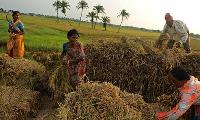
The World Trade Organization’s basic objective is to promote international trade. In the case of agricultural goods also, it stipulates rules and regulations for conducting as well as promoting international trade in agriculture goods. These rules and regulations are contained in the Agreement on Agriculture (AoA).
The AoA contains the policies to be adopted by member countries while promoting agricultural trade. For this, the AoA has three important clauses:
- Market Access
- Domestic Support and
- Export Subsidy
The market access clause instructs the level of tariff or import duty that members can impose on imports. Obviously, the AoA’s attempt is to limit tariff as low as possible.
The second clause, domestic support is the most important of the three. It generally contains regulations regarding the provision of domestic support or subsidy by member countries to their farmers.
Third clause of Export subsidy or export competition restricts member countries to give subsides for the promotion of agricultural exports.
Domestic Support
Domestic supports are subsidies given by member countries to promote their agricultural sector. On the contrary, export subsidy is to promote exports.
Different types of subsidies are given by governments to the farmers–including input subsidies, subsidies for R&D, subsidies for food security etc. The AoA classifies domestic support into trade distorting (reducible) and non-distorting (which are non reducible) categories. For trade distorting type of subsidies, the WTO sets limit beyond which members can’t give subsidies.
The AoA classifies domestic subsidies into different types; under various boxes by assigning certain colours– Green Box, Blue Box and AMS (Amber Box). This colour classification is based upon their effects on trade. The colour of the boxes is as in traffic lights: green (permitted), amber (slow down — i.e. be reduced) and a red box (prohibited); which symbolically indicates whether they have to be continued or not. The AoA signed at Uruguay has no red box.
The amber box is directly linked to production and prices and hence is considered to be trade distorting. Blue box is production limiting programs that may not distort trade. The green box doesn’t distort trade or may cause only minimum distortion. Out of these domestic support measures, WTO agreement requires reduction (non exempt/not permissible/reducible) only in AMS (amber box), whereas, support under all other heads is exempted (permissible). Besides these, three, there is a De minimis support and a Special and differential treatment box. The de minimis indicates the level trade distorting domestic support that can be given by a country within prescribed limit. For developing countries including India, the de minimis support is 10 per cent of the agricultural GDP.
*********









